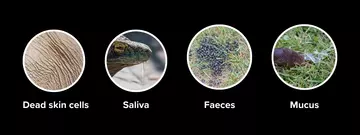
Lucy Brown
Public Engagement with Science Manager
What is eDNA?
Have you ever wished you could find out which animals have been in an area without actually seeing them? Scientists can do just that using something called eDNA, short for environmental DNA. It might sound high-tech (and it is), but the idea is actually quite simple.
So, what is eDNA?
Every living thing leaves behind tiny traces of DNA in the environment. This can come from things dead skin cells, hair, saliva, mucus or poo. This DNA gets left behind in places like soil, water, or air, and it can be collected and studied. That’s environmental DNA, or eDNA for short.
Think of it like a natural fingerprint, animals don’t even have to be seen or caught for scientists to know they were there.

How do scientists use it?
Let’s say a rare animal like the Chinese giant salamander is living in a river, but it's really hard to find because it hides in caves and rocky pools. Instead of trying to catch it or spot it (which could be tricky and stressful for the animal), scientists can take a sample of water from the river and test it for eDNA. If the salamander's DNA is in the water, it’s proof it’s been there.

Why is eDNA important?
Using eDNA helps scientists:
• Find rare or endangered animals without disturbing them
• Track changes in ecosystems over time
• Monitor pollution or invasive species
• Save time and money compared to traditional survey methods
It’s also a great tool in conservation; in understanding where animals are, it helps us to protect animals before they disappear completely.
Is it 100% accurate?
eDNA is a powerful tool, but like all science, it has its limits. DNA can break down quickly in some conditions, like warm water. Or it might be hard to detect if there’s a lot of water or too few animals. That’s why our scientists often run experiments to understand how reliable the results are.
At London Zoo, for example, researchers are testing how long salamander DNA lasts in water after they’ve left, and how long it takes for it to build up again once they’re back.
The future of wildlife tracking
eDNA is changing the way we explore the natural world. Instead of always needing to see animals, we can now detect them in a new, less invasive way. As the technology improves, we’ll be able to learn even more about the hidden creatures sharing our planet, just by reading the clues they leave behind.
eDNA in action: ZSL and the Chinese giant salamander
ZSL (Zoological Society of London) is using eDNA to help save one of the most endangered animals on the planet, the Chinese giant salamander. At ZSL London Zoo, scientists have been running experiments to test how long salamander DNA stays in water, and how quickly it builds up once an animal moves in. This research helps them design better ways to measure eDNA in the wild. In China, ZSL teams and their partners have used eDNA to search rivers and remote habitats to find out where the Chinese giant salamander might still be surviving. The results have helped shape real conservation plans for the future.

eDNA in action: Understanding coral reefs
We also use eDNA at ZSL as a tool understand the biodiversity of coral reefs. Coral reefs support high levels of diversity, i.e. they provide a home to many different species. But with global climate change and other human disturbances (over fishing, destructive fishing practices, pollution) they are becoming threatened. By using eDNA to measure this biodiversity, we can better understand the impacts humans and climate change are having to them over time.

ZSL has the full wildlife detective’s tool box
eDNA is just one part of a wildlife detective’s toolkit. A ZSL we use lots of other tools to also understand where animals have been without being there. Our hedgehog monitoring team Hogwatch use camera traps to track hedgehogs across London. Our wildlife crime team use forensic techniques to understand who has been handling animal specimens.
